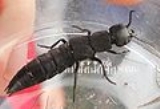
Staphylinoidea
Encyclopedia
Staphylinoidea is a superfamily
of beetle
s. It is a very large and diverse group with worldwide distribution.
The unambiguous fossil record dates back to Triassic
, and an early Mesozoic
origin of the group is probable.
Taxonomic rank
In biological classification, rank is the level in a taxonomic hierarchy. Examples of taxonomic ranks are species, genus, family, and class. Each rank subsumes under it a number of less general categories...
of beetle
Beetle
Coleoptera is an order of insects commonly called beetles. The word "coleoptera" is from the Greek , koleos, "sheath"; and , pteron, "wing", thus "sheathed wing". Coleoptera contains more species than any other order, constituting almost 25% of all known life-forms...
s. It is a very large and diverse group with worldwide distribution.
Characteristics
Most staphylinoids are middle-sized or small beetles with a pair of shortened elytra. The hind wings have no accessory posterior ridge (locking device), no wedge cell and apical cell. Abdominal 8th segment not entirely invaginated in the 7th. Head mostly without coronal suture. .Systematics and evolution
Staphylinoidea contains the following subgroups:- AgyrtidaeAgyrtidaeAgyrtidae or primitive carrion beetles are a small family of polyphagan beetles They are found in mostly temperate areas of the northern hemisphere and in New Zealand. They are feeding on decaying organic material.-Characteristics:...
C.G. Thomson 1859 - HydraenidaeHydraenidaeHydraenidae is a family of very small aquatic beetles with a worldwide distribution. These beetles are generally 1-3 mm in length with clubbed antennae. They do not swim well and are generally found crawling in marginal vegetation...
Mulsant 1844 - LeiodidaeLeiodidaeLeiodidae is a family of beetles with around 3800 described species found worldwide. Members of this family are commonly called round fungus beetles due to the globular shape of many species, although some are more elongated in shape...
Fleming 1821 = (Anisotomidae)- Platypsyllinae Ritsema 1869 or Leptinidae
- PtiliidaePtiliidaePtiliidae is a family of very tiny beetles with a worldwide distribution. This family contains the smallest of all beetles, with a length of 0.5 mm, and even the largest members of the family do not exceed 2 mm. The weight is approximately 0.4 milligrams....
Erichson 1845- Cephaloplectinae or Limulodidae Sharp 1883
- Scydmaenidae Leach 1815
- SilphidaeCarrion beetleSilphidae is a family of beetles that are known commonly as carrion or burying beetles. There are two subfamilies: Silphinae and Nicrophorinae. Both families feed on decaying organic matter such as dead animals. The families differ in which uses parental care and which types of carcasses they prefer...
Latreille 1807 (carrion beetles) - StaphylinidaeRove beetleThe rove beetles are a large family of beetles, primarily distinguished by their short elytra that leave more than half of their abdomens exposed. With over 46,000 species in thousands of genera, the group is the second largest family of beetles after the Curculionidae...
Latreille 1802 (rove beetles)- Scaphidiinae or Scaphidiidae Latreille 1807
- PselaphinaePselaphinaePselaphinae is a subfamily of small beetles. The group was originally regarded as a separate family, named Pselaphidae...
or Pselaphidae Latreille 1802
The unambiguous fossil record dates back to Triassic
Triassic
The Triassic is a geologic period and system that extends from about 250 to 200 Mya . As the first period of the Mesozoic Era, the Triassic follows the Permian and is followed by the Jurassic. Both the start and end of the Triassic are marked by major extinction events...
, and an early Mesozoic
Mesozoic
The Mesozoic era is an interval of geological time from about 250 million years ago to about 65 million years ago. It is often referred to as the age of reptiles because reptiles, namely dinosaurs, were the dominant terrestrial and marine vertebrates of the time...
origin of the group is probable.

